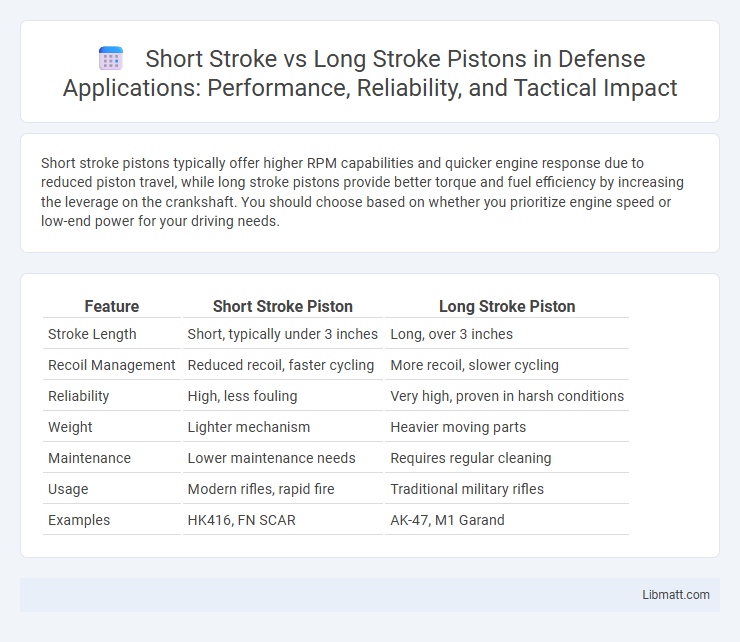Short stroke pistons typically offer higher RPM capabilities and quicker engine response due to reduced piston travel, while long stroke pistons provide better torque and fuel efficiency by increasing the leverage on the crankshaft. You should choose based on whether you prioritize engine speed or low-end power for your driving needs.
Table of Comparison
| Feature | Short Stroke Piston | Long Stroke Piston |
|---|---|---|
| Stroke Length | Short, typically under 3 inches | Long, over 3 inches |
| Recoil Management | Reduced recoil, faster cycling | More recoil, slower cycling |
| Reliability | High, less fouling | Very high, proven in harsh conditions |
| Weight | Lighter mechanism | Heavier moving parts |
| Maintenance | Lower maintenance needs | Requires regular cleaning |
| Usage | Modern rifles, rapid fire | Traditional military rifles |
| Examples | HK416, FN SCAR | AK-47, M1 Garand |
Introduction to Piston Stroke Types
Short stroke pistons feature a smaller distance between the top dead center and bottom dead center, enabling higher engine revolutions per minute (RPM) and improved high-speed performance. Long stroke pistons have a greater piston travel length, which enhances low-end torque and fuel efficiency due to increased leverage on the crankshaft. Understanding your engine's piston stroke type helps optimize power output and driving characteristics tailored to your needs.
Defining Short Stroke Pistons
Short stroke pistons feature a reduced piston travel distance compared to long stroke pistons, resulting in faster engine revs and improved high-RPM performance. These pistons reduce friction and inertia, enabling quicker throttle response and enhanced engine efficiency in sporty applications. You benefit from increased power output and smoother operation in engines designed for dynamic driving conditions.
Understanding Long Stroke Pistons
Long stroke pistons feature a greater distance between the crankshaft centerline and the piston pin, resulting in increased torque and improved low-end power delivery for engines. This design enhances combustion efficiency by promoting better mixing of air and fuel, which can improve fuel economy and emissions performance. Understanding long stroke pistons helps you choose the right engine configuration for applications requiring strong torque and smooth power output at lower RPMs.
Key Differences Between Short and Long Stroke Pistons
Short stroke pistons have a shorter distance of travel within the cylinder, allowing higher engine RPM and improved power output, while long stroke pistons feature a longer travel distance, enhancing torque and fuel efficiency. The shorter stroke reduces piston speed, decreasing mechanical stress and enabling quicker acceleration, whereas the long stroke increases leverage on the crankshaft, optimizing low-end performance. Your engine's purpose and driving style determine whether the short stroke's high-rev capability or the long stroke's torque advantage is more beneficial.
Performance: Power and Torque Output
Short stroke pistons typically deliver higher power output due to their ability to rev at higher RPMs, enhancing peak horsepower. Long stroke pistons generate greater torque at lower RPMs, improving engine efficiency and responsiveness in everyday driving conditions. Understanding your performance needs helps determine whether you prioritize maximum power or consistent torque for optimal engine performance.
Engine Efficiency and Fuel Consumption
Short stroke pistons typically improve engine efficiency by allowing higher RPMs and faster combustion cycles, resulting in better power output and reduced fuel consumption. Long stroke pistons enhance torque at lower RPMs but may lead to increased friction and less efficient fuel usage during high-speed operation. Your choice between these piston types should balance desired power characteristics with fuel economy goals.
Impact on Engine Longevity and Durability
Short stroke pistons reduce piston speed and lower mechanical stress on engine components, enhancing overall engine longevity and durability. Long stroke pistons generate higher torque at lower RPMs but increase side forces on cylinder walls, potentially accelerating wear and decreasing durability. Selecting a short stroke design often results in better long-term engine reliability due to reduced friction and thermal load.
Application Suitability: Best Uses for Each Type
Short stroke pistons are ideal for high-performance engines requiring rapid acceleration and high RPMs, such as in racing cars and motorcycles, due to their reduced reciprocating mass and improved throttle response. Long stroke pistons provide greater torque and fuel efficiency at lower RPMs, making them suitable for heavy-duty vehicles, trucks, and applications focused on durability and fuel economy. Selecting between short stroke and long stroke pistons depends on whether the primary goal is high-speed power output or steady, low-end torque and efficiency.
Maintenance and Cost Considerations
Short stroke pistons typically require less maintenance due to reduced friction and lower stress levels, which can extend engine life and lower overall service costs. Long stroke pistons often experience higher wear and tear, leading to more frequent maintenance intervals and potentially higher costs for parts and labor. Choosing between the two affects your budget and maintenance schedule based on engine performance and durability requirements.
Conclusion: Choosing the Right Piston for Your Needs
Short stroke pistons deliver higher RPM and quicker engine response, making them ideal for performance-focused applications. Long stroke pistons provide greater torque and fuel efficiency, better suited for everyday driving or heavy-duty tasks. You should select a piston type based on whether you prioritize speed and power or durability and fuel economy.
short stroke piston vs long stroke piston Infographic

 libmatt.com
libmatt.com